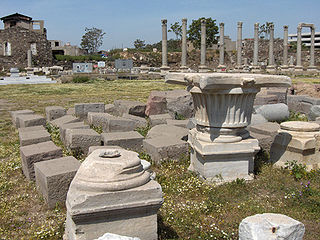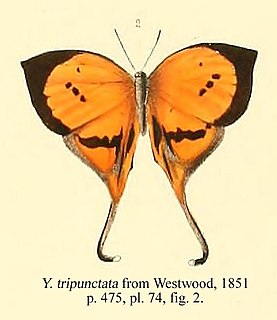| Pitane | |
|---|---|
| Scientific classification | |
| Kingdom: | Animalia |
| Phylum: | Arthropoda |
| Class: | Insecta |
| Order: | Lepidoptera |
| Superfamily: | Noctuoidea |
| Family: | Erebidae |
| Subfamily: | Arctiinae |
| Subtribe: | Phaegopterina |
| Genus: | Pitane Walker, 1854 |
| Pitane | |
|---|---|
| Scientific classification | |
| Kingdom: | Animalia |
| Phylum: | Arthropoda |
| Class: | Insecta |
| Order: | Lepidoptera |
| Superfamily: | Noctuoidea |
| Family: | Erebidae |
| Subfamily: | Arctiinae |
| Subtribe: | Phaegopterina |
| Genus: | Pitane Walker, 1854 |

Arcesilaus was a Greek Hellenistic philosopher. He was the founder of Academic Skepticism and what is variously called the Second or Middle or New Academy—the phase of the Academy in which it embraced philosophical skepticism.

Autolycus of Pitane was a Greek astronomer, mathematician, and geographer. The lunar crater Autolycus was named in his honour.

Aeolis, or Aeolia, was an area that comprised the west and northwestern region of Asia Minor, mostly along the coast, and also several offshore islands, where the Aeolian Greek city-states were located. Aeolis incorporated the southern parts of Mysia, and is bounded by it to the north, Ionia to the south, and Lydia to the east.
Harishankar Parsai was a Hindi writer. He was a noted satirist and humorist of modern Hindi literature and is known for his simple and direct style. He wrote vyangya (satire).
Ekrem Akurgal was a Turkish archaeologist. During a career that spanned more than fifty years, he conducted definitive research in several sites along the western coast of Anatolia such as Phokaia (Foça), Pitane (Çandarlı), Erythrai (Ildırı) and old Smyrna.
Pitane may refer to:
Elaea was an ancient city of Aeolis, Asia, the port of Pergamum. According to the Barrington Atlas of the Greek and Roman World, it was located near the modern town of Zeytindağ, İzmir Province, Turkey. The ruins of the silted port's breakwater can be seen on satellite maps at 38°56'35.54"N 27°2'16.34"E.
Autolycus may be:

Çandarlı is a coastal township with own municipality within the district of Dikili in western Turkey's İzmir Province. It is a well-developed town and an important tourist resort. Çandarlı is situated on the northern coast of the and opposite the important industrial center of Aliağa, another district center.

Pitane, near Çandarlı, Turkey, was an ancient Greek town of the ancient region of Aeolis, in Asia Minor. It was situated near the mouth of the river Evenus on the bay of Elaea. It was one of the eleven ancient Aeolian settlements, and possessed considerable commercial advantages in having two harbours. It was the birthplace of the academic philosopher Arcesilaus, and in the reign of Titus it suffered severely from an earthquake. The town is still mentioned by Hierocles. Pliny the Elder mentions in its vicinity a river Canaius, which is not noticed by any other writer; but it may possibly be the river Pitanes, spoken of by Ptolemy, and which seems to derive its name from the town of Pitane.
In Greek mythology, the name Myrina or Myrine may refer to the following individuals:

Yasoda is a genus of butterflies in the family Lycaenidae. The species in this genus are found in the Indomalayan realm.

Notion or Notium was a Greek city-state on the west coast of Anatolia; it is about 50 kilometers (31 mi) south of Izmir in modern Turkey, on the Gulf of Kuşadası. Notion was located on a hill from which the sea was visible; it served as a port for nearby Colophon and Claros, and pilgrims frequently passed through on their way to the oracle of Apollo at Claros. There are still remains of the defense walls, necropolis, temple, agora, and theater. The ruins of the city are now found east of the modern town Ahmetbeyli in the Menderes district of Izmir Province, Turkey.
Pitane fervens is a moth in the family Erebidae first described by Francis Walker in 1854. It is found in South America.

Bergama Museum is a museum in Bergama district of İzmir Province, Turkey.
Teuthrania was a town in the western part of ancient Mysia, and the name of its district about the river Caicus, which was believed to be derived from a legendary Mysian king Teuthras. This king is said to have adopted, as his son and successor, Telephus, a son of Heracles; and Eurypylus, the son of Telephus, appears in the Odyssey as the ruler of the Ceteii. The town was situated between Elaea, Pitane, and Atarneus. The nearby towns of Halisarna, Pergamum, and Teuthrania had been given by the Persian king Darius I to the Spartan king Demaratus about the year 486 BCE for his help in the expedition against Greece. Demaratus's descendants continued to rule these cities at the beginning of the 4th century BCE. During the withdrawal of Pergamum from The March of the Ten Thousand, it was attacked by, among others, troops from Halisarna and Teuthrania under command of Procles, son of Demaratus. In the Hellenica, Xenophon relates that Teuthrania, together with Pergamum, Halisarna, Gambrium, Palaegambrium, Myrina and Gryneium were delivered by their rulers to the army that, under the command of the Spartan Thimbron, around the year 399 BCE, had come to the area to try to liberate the Greek colonies from the Persian domain.
Pitane, or Pitana (Πιτάνα), was a settlement that existed before the Dorian conquest. It was united with three other such settlements by a common sacrifice to Artemis, and eventually coalesced into ancient Sparta. Pitane is called a polis by Euripides, and is also mentioned as a place by Pindar. Herodotus, who had been there, calls it a deme. He also mentions a λόχος Πιτανάτης; and Caracalla, in imitation of antiquity, composed a λόχος Πιτανάτης of Spartans. It appears from the passage of Pindar quoted above, that Pitane was at the ford of the Eurotas, and consequently in the northern part of the city. It was the favourite and fashionable place of residence at Sparta, like Collytus at ancient Athens and Craneion at Corinth. We are also told that Pitane was near the temple and stronghold of Issorium.
Atarneus, called Atarneus sub Pitanem to distinguish it from the other city of the name, was a town of ancient Aeolis near Pitane.
Pitane was the Naiad-nymph of the spring, well or fountain of the town of Pitane (Laconia). A daughter of the river god Eurotas, became by Poseidon the mother of Evadne. The town of Pitane was named after her.
| This Phaegopterina-related article is a stub. You can help Wikipedia by expanding it. |